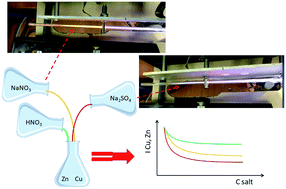Effects of acid, sodium and its salt counterions on the atomic emission of copper and zinc in plasma pencil
Abstract
Copper, zinc and sodium atomic line emissions in the plasma of a pencil discharge under the influence of easily ionizable elements (EIE), counterions and nitric acid were studied. These elements were introduced as the water solutions of nitrates and sulfates using an ICP-adopted nebulization system. The plasma pencil as a radiation source was operated in argon at 4 L min−1 powered by a 13.56 MHz generator at 140 W. The most intense depressing effect on the atomic emission of zinc (down to 15% of the unaffected intensity) and copper (down to 35%) appeared with sulfates. A lower effect was observed with chlorides (down to 70% for Zn and 30% for Cu) and the lowest effect was observed with nitrates, which increased the value for Zn by up to 40% and decreased that for Cu to about 50%. Nitric acid has a certain depression effect down to further 50% with salts, 80% for Cu, and 65% for Zn without salts; it also had a stabilization effect, partially compensating for the depression (double intensity for Cu with NaCl and HNO3 against sole NaCl) by anions and EIE. A combination of nitric acid with an added excess amount of an EIE salt could then provide predictable intensities. Sodium is a representative of EIE and it is a constituent of the introduced nitrate and sulfate salts. The sodium intensity dramatically decreased in the presence of sulfates, which might be a consequence of the reactions and energy exchange with the sulfur species in the plasma.



 Please wait while we load your content...
Please wait while we load your content...